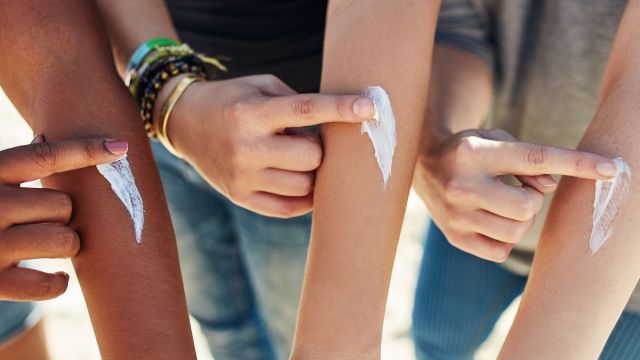Updated on May 23, 2022.
You know it’s important to use sunscreen to protect your skin. But with so many options to choose from, it’s easy to feel overwhelmed.
Worry no more.
With the following expert-approved information, you’ll know exactly what to look for.
Get the scoop on the right ingredients
There are two main types of sunscreen on the market: physical and chemical. Physical sunscreens, also referred to as “mineral” sunscreens, contain the active ingredients titanium dioxide and/or zinc oxide. They protect you by sitting on top of your skin and deflecting the sun’s rays.
Chemical sunscreens, on the other hand work by absorbing the sun’s rays. They contain ingredients such as oxybenzone, avobenzene, and homosalate.
At the end of the day, both are equally effective, says Adam Friedman, MD, a dermatologist at the George Washington University School of Medicine in Washington, D.C. Physical sunscreens tend to last slightly longer when you’re in direct UV light and are less likely to cause burning or irritation, which can be a side effect of some chemical sunscreens. But even newer, micronized versions of physical blockers can leave a whitish cast on the skin. They can also rub or sweat off more easily than chemical sunscreens.
If you do opt for a chemical sunscreen, make sure that you buy one with at least three sunscreen ingredients. “If you use a chemical product with multiple filters, it’s less likely that one of those ingredients will be at levels high enough to cause irritation,” explains Dr. Friedman.
You can also opt for a sunscreen that contains both physical and chemical blockers. Although there’s no research that these are any more effective, “you do have the advantage of hitting UV rays at every level,” says Friedman.
Sunscreen safety concerns
You may have read about safety concerns surrounding chemical UV filters like oxybenzone. But most studies in humans haven’t shown any adverse effects, according to the American Academy of Dermatology. These substances are also considered by the U.S. Food & Drug Administration (FDA) to be acceptable active ingredients in sunscreens.
The same is true for the inactive ingredient retinyl palmitate (a form of vitamin A). A 2017 analysis published in the International Journal of Toxicology found no evidence that using this substance in sunscreen causes cancer in humans. That said, pregnant women may want to avoid using sunscreens with retinyl palmitate out of an abundance of caution.
In 2021, Valisure, an independent laboratory, discovered a cancer-causing agent called benzene in several over-the-counter drugstore products, including some Aveeno, Neutrogena, and Coppertone sunscreens. Though the levels of benzene found were very low, the items were voluntarily recalled by their parent companies out of an abundance of caution. It is important to note that benzene is not an ingredient in sunscreens; some experts have theorized the samples were contaminated, or perhaps the benzene emerged as part of the manufacturing process.
Figure out which type is best for you
Sunscreens now come in many forms—creams, lotions, gels, sticks, and sprays. In general, creams are good for people with very dry skin, especially around their faces. Lotions are better for large areas like your chest, back, or legs, especially since lotions tend to feel lighter and less greasy than creams. Gels are best for hairy areas, like your scalp or a man’s legs or chest. Sticks are useful for applying around delicate areas such as your eyes.
Sprays are also a good idea but can be trickier. “We don’t really know how much spray is enough to provide good UV protection,” says Friedman. “I tell patients to actually cup their hand and spray a puddle of sunscreen into it, then apply it like they would a gel or a lotion.”
This method of using spray sunscreen has another added advantage: You’ll be less likely to inhale it.
“The spray can irritate your upper airways, and we also don’t know how safe the ingredients are to breathe in, since there really haven’t been studies done looking at that,” explains Friedman. If you do spray, keep the nozzle close to your skin—no farther than about 2 centimeters away, he advises.
Make sure you’re applying—and reapplying—enough
Groups like the Skin Cancer Foundation and American Academy of Dermatology (AAD) recommend applying 1 ounce of sunscreen to your body—the equivalent of a shot glass. In fact, research shows most people only apply a quarter to half of that amount, which means they aren’t getting the protection they need.
In reality, dermatologists say, an exact amount is hard to pin down.
“An ounce might be enough for a woman who is 5’2’’, but not for a man who is 6’3’’,” says David Leffell, MD, chief of dermatologic surgery at the Yale University School of Medicine. When applying sunscreen, you should put enough on to cover the entire area but “don’t apply it like icing on a cake,” he adds. “You should massage it into your skin until there’s no noticeable residue.”
If you’re still confused, the Skin Cancer Foundation says the average person should use up a 4-ounce bottle of sunscreen if they’re spending a long day outside.
If you’re applying a stick to an area—for example, around your eyes—make sure you’ve swiped the spot at least four times, says Friedman. As for spray, there’s no good rule of thumb, but “you should be able to see the liquid on your skin,” he adds.
Remember to apply a lip balm with SPF to your lips as well, since you can also potentially get skin cancers on your kisser. You should also reapply sunscreen every two hours when you’re outdoors, or right after swimming or sweating.
Water resistance is a key feature to look for when shopping for sunscreen. Bear in mind, though, that even if the sunscreen says it is water-resistant, you still need to reapply it every time you get out of the pool or the ocean.
“All the water-resistant label means is that you can swim with the sunscreen on for 40 minutes or 80 minutes before the chemicals in it become ineffective,” explains Friedman. “It’s also likely that it’s been removed from the skin by water or sweat.”
Use an SPF of at least 30
SPF—or sun protection factor—measures a sunscreen’s ability to prevent UVB rays from damaging your skin. Groups like the AAD recommend wearing an SPF of at least 30, which blocks 97 percent of the sun’s UVB rays. An SPF of 50 blocks 98 percent. But while that may not seem like a big difference, “even that little amount can have an effect if you are very fair-skinned or have other risk factors for skin cancer,” says Friedman.
There’s another reason to go with a higher SPF: Many sunscreens don’t actually meet their labeled SPF level.
Such was a finding from testing of sunscreens by Consumer Reports (CR). The group, like the AAD, recommends using products with SPF levels of at least 30. In order to maintain a margin of error in case a product doesn’t contain its claimed SPF, CR advises choosing sunscreen with SPF levels of at least 40.
Just keep in mind that whatever the SPF, all sunscreens last around the same amount of time. It’s important to reapply at least every two hours—possibly more often, depending on your skin type and the activity you’re performing—and always after swimming or sweating.
When buying sunscreen, it’s also important to make sure that the label says “broad-spectrum.” This means that it also protects against UVA rays, which—although they cause less burning—have also been linked to skin cancer. Sunscreens billed as broad-spectrum are also required to provide “proportional” protection, which means that a product with an SPF of 30, for example, must have a comparable level of protection against UVA.
Don’t just rely on sunscreens
In addition to coating your bare skin, you can avoid sun protection miscues by gearing up with the following items:
Sunglasses: These won’t just prevent you from developing skin cancer on your eyeballs (which can happen), they also reduce your chances of developing vision-threatening conditions later in life, such as cataracts or macular degeneration. Wear sunglasses that block 99 to 100 percent of both UVA and UVB light (which should be noted on the glasses’ label).
Hat: A hat with at least a 3-inch brim can block as much as half of all UVB rays from your delicate eye area, according to the Skin Cancer Foundation. A hat also does double duty by offering protection in places where it’s hard to apply sunscreen, like your scalp, ears, and the back of your neck.
Sun-protective clothing: To help prevent sunburn when you were growing up, your parents may have dressed you in a white t-shirt when you were swimming. But a lightweight wet t-shirt only provides an SPF of about 3. When you’re going to be at the pool or beach, consider buying high-UPF swimwear, which offers the same protection as sunscreen. Or you can increase your clothes’ UPF on your own by washing them with a special laundry additive that contains sunscreen, like Sun Guard’s Rit, which provides protection for up to 20 washings.







